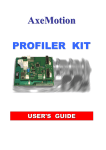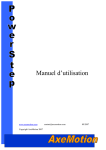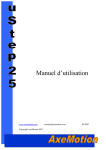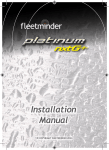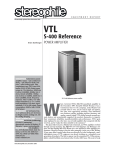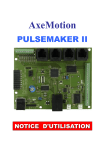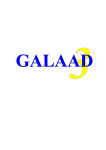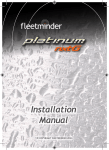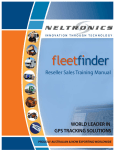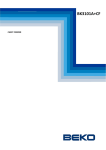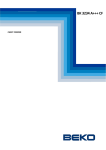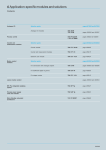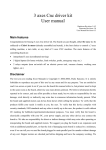Download PULSEBOX NxtG - AxeMotion CNC Controller
Transcript
AxeMotion PULSEBOX NxtG USER'S GUIDE SAFETY INSTRUCTIONS Please keep this user's guide! It contains important instructions you should refer to when installing, maintaining and using your AxeMotion module and the machine it drives. It has been written for people who use, configure, install, handle or maintain this hardware. Electric hazard: To avoid risks of fire and injuries due to electric shocks, pay attention to the safety guidelines when using this product. - Carefully read and study the instructions of this user's guide. - Always use a grounded outlet for the electric connection of the machine. If you do not know if your socket outlet provides a ground plug, then get information from a qualified electrician. - Unplug all electrical connections before cleaning the hardware. - Do not install the AxeMotion module or the machine it drives near water or in an moist environment. Do not handle or use the machine if you are wet. - Always install your hardware on a stable flat bed, in a clean and protected place where nobody can step or stumble on electric connection cables. Safety instructions for use: Warning: to avoid any risk of injury due to eventual projections when using an automated machine tool, including in manual mode, you must imperatively wear safety eyeglasses. Furthermore, depending on the type and the use of your machine, it must be integrated in an approved safety cabinet or protected area. --2-- WARRANTY / LIABILITY The AxeMotion CNC modules are guaranteed against defects in materials and workmanship for one full year from the date of purchase. This warranty cannot apply if electrical connections and prescriptions of use that are described in this guide have been strictly observed. An installation that does not comply with these prescriptions invalidates the warranty for consequent damages. AxeMotion CNC modules are provided without any warranty, even implicit, concerning the results that can be obtained by their use, or the fact that any user will be able to run them successfully, or regarding overall satisfaction with the end products which can be obtained using the modules. The purchaser explicitly recognises that he/she is solely responsible for choosing this module, for running and using it and its related software, and for obtaining the actual results. Connecting an AxeMotion CNC module requires skills in electrical wiring and connecting, in motors and power stages, and in computerised motion control. After integrating a CNC module, it is strongly recommended that the purchaser begins to get familiar with the machine control by making the first tests on valueless workpieces. Strict safety rules exist for building or using an automated machine tool. These rules must be observed very accurately, and especially for the electrical wiring, the containment of mobile parts in a protection cabinet, the risks of injury caused by impacts of chips or fragments of broken tools. No liability can be accepted concerning the AxeMotion modules, their manufacturer or distributor, for direct or indirect damages caused by a misuse or non complying use, on persons who handle the module or the machine it drives, on objects or materials subject to machine work, or on computer data subject to the software processes. Obviously none of the above terms and conditions may affect your statutory rights under current law or legislation. --3-- CHARACTERISTICS Miscellaneous: Almost all power stages for stepper motors, and many servodrives are controlled by couples of 5V signals Clock (or Pulse, i.e. rotation of an increment) and Direction (rotation sense). AxeMotion CNC modules are able to produce these signals in an intelligent way by receiving and processing high-level commands that are sent by the supervision software. In spite of its compactness, the AxeMotion PulseBox NxtG module is a complete and high performance computerised numerical controller that includes advanced functions. Its internal memory buffer and the availability of different linear interpolation modes render it capable of producing motion with a rare fluidity, especially in non-circular curves. Its plug-and-play connection on USB port and the possibility to freely setup the assignation of signals on the output connector make it a mini-controller of a surprising ease of integration in existing machines. Aiming to replace directly the old controls through LPT parallel port, the AxeMotion PulseBox NxtG module offers instead the full power of a modern computerised numerical control, without complicated wiring and without any hazardous modification of the heart of the operating system of the computer that runs the application software. The AxeMotion PulseBox NxtG has a latest generation 32-bit ARM RISC, you have a product with the best technology and a processor belonging to a lineage whose reputation is second to none. For the sake of quality PulseBox NxtG Module consists of a 4-layer PCB and uses only high-end components, it also has several ESD protection circuits for signals leading to the DB25 connector and the USB connector. We have stopped at nothing in terms of quality and durability of this product. Not to be outdone production is carried out in France in a production unit ISO 9001:2008 certified, using tools at the cutting edge of technology. --4-- Technical data: - Native USB transmission at ultra-fast speed - Connection and power supply from USB port (consumption < 90 mA) - Complete emulation of old CNC drives through parallel port - Control of 4 axes, simultaneously interpolated - Maximum frequency 100 KHz in interpolation - Local memory buffer 6 Kb (400 commands ahead) - Interpolations with constant speed, variable speed, and double-ramps - Management of fast braking along multiple vectors - Override function for real-time control of motion speed - 8 inputs, 16 outputs, including Clock & Dir motor signals - PWM output for spindle rotation or hot wire control - Extra inputs/outputs aside the DB-25 - Settable assignment of the signals on the DB-25 connector - 4 Layers PCB - ESD protection for DB25 and USB connectors pins --5-- WIRING The AxeMotion PulseBox NxtG module has three connectors: - The USB cable must be plugged on the host computer (USB 2.0 connection, USB 1.1 compatible). Generic driver (no installation). - The DB-25 connector emulates the LPT parallel port and should be plugged on the motor power stage. To preserve the LPT compatibility, the topology is the same as a printer port. Therefore, Clock & Dir signals of the 4 axes can be located only on pins 2 to 9, and pins 18 to 25 are grounded. Other signals are freely assignable on the pins from the application software so they match the power stage specifications, provided that any LPT output signal indeed corresponds to an output, and any LPT input signal corresponds to an input. If managing less than 4 axes, the pins 2 to 9 that remains available can then be reused for driving classical binary outputs (except the PWM output that cannot be assigned to one of these pins 2 to 9. - An extension connector (to solder) at the top of the box provides a ground pin, 5V pin, and an extra set of 4 outputs and 3 inputs. If the power stage does not use signals except Clock & Dir, then it remains possible to manage these supplementary inputs and outputs, for example to trigger a spindle or connect sensors. --6-- Note : From stock, the enclosure is not machined to provide access to this connector. As it's rarely used, we though better to keep a good protection from dust. Important: inputs and output are not opto-isolated. Furthermore, outputs can only provide a current of 10 mA each (this is still more than a LPT port can do), with a total of 50 mA maximum for the whole set of outputs. Consequently, a bad connection or an overload may cause damages in the PulseBox NxtG module, or even in the host computer. So it is very important to make sure that all devices that are driven by the module are carefully isolated and do not require too much current. --7-- PARAMETERS IN GALAAD Galaad integrated software for CAD-CAM-CNC is compatible with the AxeMotion PulseBox NxtG mo-dule that it can drive in optimal conditions. In Galaad or one of its related modules, call the menu command "Parameters / Machine / Full data". The page "Table" allows you to select the AxeMotion modules and also the number of axes of the machine, the screw pitches and the number of pulses per motor revolution (microstepping). Please enter here the values that correspond to your machine and its power stage. Click then at top on the tab that correspond to the page "Controller" and indicate here that the communication runs on a USB port. Important detail: it is necessary to tell Galaad where the machine zero position is located (generally left-hand side and either the front or the back of the table). This is going to define the orientation of the machine. --8-- Now you must setup the internal data of the PulseBox NxtG module, and also the signals on the pins of the DB-25 connector that links to the power stage. Still in this page "Controller" of Galaad machine parameters, click on the small button "More…" which is located at top-right of the dialog box, aside the controller type. This opens a sub-window that gives you access to special parameters. The status of outputs at boot allows you to indicate whether an output should be enabled as soon as the module is powered on, for example to control a safety device or activate the power stage even before Galaad is running. The start/stop frequency and the acceleration depend on the mechanical characteristics of your machine (inertia, motor power, gear factors). So it is not possible to give standard values and it is up to you to try different settings. Let us say that the start/stop frequency is the initial starting speed of a motor (instant jump from immobility to motion and reciprocally). If your motor "knocks" when starting, then you must reduce the value. On the other hand, if the motion starts from a too low speed, then you must increase it. The acceleration indicates the slope of the increasing motor speed when beginning a motion, from start/stop frequency, and of course decreasing speed when ending the motion. If the motor seems to be too weighted, then reduce the value. If it looks too "soft", then increase it. The error or stop signal will abort the current motion in progress and the automatic process immediately if a critical input state changes, for example a secur- --9-- ity contact or the Drag-Error bit of a servodrive. Important: for the inputs, an "Enabled" polarity corresponds to a normally open (N.O.) circuit or switch; while a "Disabled" polarity corresponds to a normally closed (N.C.) circuit. Galaad receives from AxeMotion the eventual corrections, new functions and updates of the firmware (the internal microprogram) of the CNC modules. Consequently, updating Galaad can induce an automatic CNC card firmware update if the option is ticked. Anyway Galaad will ask you to confirm before updating the CNC module firmware, which takes about 15 seconds. The data transfer corresponds to the speed of the USB flow towards the AxeMotion module. Default setting is "very-fast" and can be set to "fast" if you experience communication problems with the AxeMotion module, which problems are usually due to noise in the circuit, generated by sources of electrical parasites (big motors starting, neon lights, etc.). The zero-end switches correspond to the reset of absolute co-ordinates, i.e. the machine zero point, using a reference run. This reset is managed by Galaad that must know which binary inputs correspond to the axis end switches and their polarity (normally closed or normally open). Important: if you do not know where the axis end switches are connected to, then call "Parameters / Machine / IO test" to see which switch correspond to which input with which polarity. A normally dark input that becomes light when the switch is triggered corresponds to an "enabled" polarity. Reciprocally, if the input is normally light and becomes dark when the switch is triggered, then the polarity is "disabled". The right-hand side of the window allows you to set the pin assignment of the output signals of the DB-25 connector. Just indicate which signal goes to which pin, avoiding redundancies. Please note that Clock (pulse) and Dir (direction) signals can be output to pins 2-9 only, and the eventual PWM signal cannot be output to these 2-9 pins, so the PulseBox NxtG remains compatible with an LPT parallel port. All other configurations are allowed. Please refer to Galaad user's manual for more advanced information about this software and its parameters. --10-- www.axemotion.com AxeMotion / 106 rue de la placette RCS Grasse 411 582 471 / / 06620 Cipieres / France SIRET 411 582 471 00024 Copyright © 2011 AxeMotion / All rights reserved --11--











